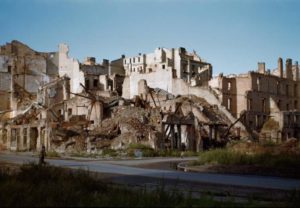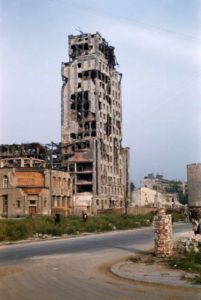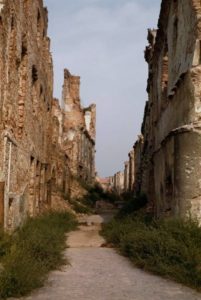 On August 19th the general attack on the Old Town began with fire from Panzer trains, Krowas and artillery fire that preceded a line of Goliaths used to destroy barricades and buildings followed by Tiger tanks and then foot soldiers moved in.
On August 19th the general attack on the Old Town began with fire from Panzer trains, Krowas and artillery fire that preceded a line of Goliaths used to destroy barricades and buildings followed by Tiger tanks and then foot soldiers moved in.
The old town was pounded relentlessly and reduced to rubble and most of the civilians were killed in the process, members of the AK escaped through the sewers to fight elsewhere. Once the Germans had entered the Old Town they found mostly rubble, with nothing left standing and about 35,000 survivors hiding in basements, many of whom would later be killed or sent to work in the Reich…”
150,000 civilians and 18,000 AK soldiers are killed during 1944 Uprising. Obersturmbannfürher Dr. Ludwig Hahn and his battalion of 700 SS men kill 2,000 people on Aleja Szucha alone.
After Ochota, Wola, the Old Town, the suburban districts of Mokotów and Żoliborz are destroyed and pacified, the City Centre is attacked. Once the AK (Polish Home Army) capitulates, on Hitler’s orders (see next), a massive expulsion of the remaining 520,00 civilians through the Pruszków Transit Camp begins, of which 60,000 are sent to concentration camps and 90,000 to work camps in the Reich and 18,000 to POW camps. Thousands of Polish orphans are sent to the Reich to be given to childless German couples. Families are deliberately torn apart at this transit camp, many to never be reunited.
 Hitler issues Führer Order (ARLZ – Auflockerung, Räumung, Ladung und Zerstörung) to Warsaw Obergruppenführer Erich von den Bach on August 1, 1944 and reissues it on October 9, 1944, ordering that the city was to be glattraziert (levelled), all raw materials, furnishings were to be sent to the Reich (nearly 23,300 train car loads), while most Warsawians surviving the suppression of the Warsaw uprising were to be used as slave labourers for the Reich, sent to concentration camps or dispersed and Jews that survived the pacification of the Warsaw ghetto were all to be killed.
Hitler issues Führer Order (ARLZ – Auflockerung, Räumung, Ladung und Zerstörung) to Warsaw Obergruppenführer Erich von den Bach on August 1, 1944 and reissues it on October 9, 1944, ordering that the city was to be glattraziert (levelled), all raw materials, furnishings were to be sent to the Reich (nearly 23,300 train car loads), while most Warsawians surviving the suppression of the Warsaw uprising were to be used as slave labourers for the Reich, sent to concentration camps or dispersed and Jews that survived the pacification of the Warsaw ghetto were all to be killed.
Himmler told during SS Officers’ conference: “The city must completely disappear from the earth and serve only as a transport station for the Wehrmacht. No stone is to remain standing. every building must be razed to its foundations, the quarters for the army will be set up in basements, there will be no barracks, only technical equipment and the railways buildings will be left.”
A Detailed list is drawn up by Herr Weisker of the Nazi Economic Office in occupied Poznan of who was to get what. Warsaw was to be stripped of everything useable from gum, paraffin, leather goods to iron machinery, wires, cables, ovens, textiles, rope, paper, electrical equipment etc. This is not to mention the looting by regular soldiers. Major Max Reck’s Kampfgruppe broke into the Emisyjny Bank and stole 250 million zloty.
Reich Agent for Fashion Benno von Arent takes charge of plunder of looting the National Museum. Art was looted from private homes and churches as well.
 By November 20 the city is picked bare by Gruppenführer Heinz Reinefarth‘s units which were then cleaned and sorted in the Warthegau (Nazi-occupied Polish territory incorporated into the Reich comprising mainly of Western Poland.
By November 20 the city is picked bare by Gruppenführer Heinz Reinefarth‘s units which were then cleaned and sorted in the Warthegau (Nazi-occupied Polish territory incorporated into the Reich comprising mainly of Western Poland.
Generalmajor Helmuth Eisenstück is appointed Commandant of Fortress Warsaw and given the duty to destroy what is left of it. A region of about 17 square kms is to be razed to the ground.
Sapper units specialized in the burning and demolition of buildings from Organization Todt are enlisted.
A special Verbrennungskommando unit led by SS Oberleutenant Kruger was formed to burn buildings using flamethrowers.
Another unit led by engineers drilled holes into the sides of palaces, churches and schools for dynamite in order to then explode the structure
Most of the vast collection of the Krasinski Library founded in 1844 was shelled and set on fire and almost completely burned by October 1944
On October 20 the Załuski Library, the oldest public library in Poland dating from 1744 was burned alomg witgh 400,000 books – only 1800 manuscripts survived; The Czartoryski libraries are burned, only a hundred out of thousands of manuscripts are saved
On October 20 the National Archives are destroyed, only 4 percent survive.
 The Polish Library created during Poland’s partitions in Rapperswil Switzerland is set on fire and destroyed.
The Polish Library created during Poland’s partitions in Rapperswil Switzerland is set on fire and destroyed.
In a December 1944 report Ludwig Fischer called what was done to Warsaw a…”military achievement of the highest rank.” A special badge was made depicting a gigantic eagle with a swastika around its neck crushing a twisted serpent in its long talons with Warschau 1944 emblazoned on it.
By January 1945 85 percent of the buildings of Warsaw are destroyed, 10,455 out of a total of 24,724 buildings are reduced to actual rubble, the rest were burned out hulks unsuitable largely for restoration. 925 historical buildings are destroyed; 25 churches and synagogues, 14 libraries, 81 primary school, 64 high schools, the University of Warsaw, the Warsaw University of Technology, monuments of all kinds, museums, squares, palaces not to mention hundreds of thousand of regular homes were gone.
The destruction ends on January 17, 1945 with Soviet invasion of the left bank of Vistula river.
100,000 people are arrested by Soviets between August 1944-August 1945, many are AK members who drove the Uprising, many are transported to remote Soviet territories never to return again.
US General Dwight D. Eisenhower visited the city after the war and was quoted as saying: “I have seen towns destroyed, but nowhere have I been faced with such destruction.”
To be continued…
0 Comments
Leave a reply
You must be logged in to post a comment.
